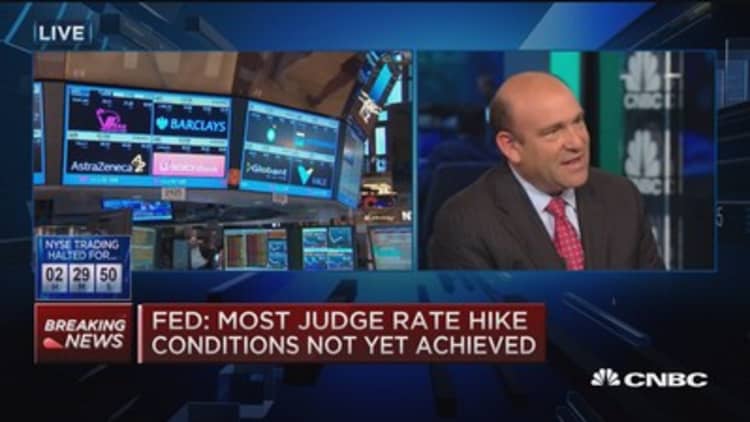
Federal Reserve officials struck a notably dovish tone in their most recent discussions about monetary policy, while at the same time setting the groundwork for future rate hikes.
Minutes released Wednesday from the June Fed Open Market Committee meeting reveal the thinking behind yet another delay in normalizing policy. Members agreed the economy was getting better yet felt unready to exit a policy of zero interest rates that began in late 2008.
Future hikes, though, would be detailed in an "implementation note" that would explain the moves. The Fed hasn't hiked rates in nine years.
"Most participants judged that the conditions for policy firming had not yet been achieved; a number of them cautioned against a premature decision," the minutes said.
"Many participants emphasized that, in order to determine that the criteria for beginning policy normalization had been met, they would need additional information indicating that economic growth was strengthening, that labor market conditions were continuing to improve, and that inflation was moving back toward the Committee's objective."
Though government bond yields edged lower, market reaction was muted to the Fed minutes, which reflected sentiments from a meeting prior to Greece rejecting an austerity referendum and before a sharp selloff in Chinese stocks. Major indexes had been in a selloff throughout the day's trading, and the dovish Fed did little to lighten the mood.
Had the Fed been privy to what was to come globally, it may have sounded an even more cautious tone.
"You can't ignore that potential impact, not just market-wise but economically of what's going on in Europe and what's going on in China," said Kathy Jones, fixed income strategist at Charles Schwab. "They're prepared to deal with market events globally. They'll say that's not really their concern. But when it drags on to this extent and as significant as it's been, it has to give them pause."
Economic signals have been mixed this year. Job creation has continued apace but inflation has remained muted. Gross domestic product contracted 0.2 percent in the first quarter, a condition most Fed officials were willing to write off as "transitory," while manufacturing lagged and housing indicators were mixed.
"While participants generally saw the risks to their projections of economic activity and the labor market as balanced, they gave a number of reasons to be cautious in assessing the outlook," the minutes said.
In addition to domestic conditions, members expressed worries about Greece, which is teetering toward a full debt default and exit from the euro zone.
That caution led the FOMC to keep its target rate near zero, even after ending the quantitative easing stimulus program in October 2014.
However, the minutes showed some members itchy to get things moving on the road to rate normalization.
"Some participants viewed the economic conditions for increasing the target range for the federal funds rate as having been met or were confident that they would be met shortly," the minutes said.
Holding off on raising rates could cause the Fed to have to move too rapidly once tightening began, due to increasing inflation, these members said. They also worried the Fed could lose face in the markets if it didn't follow through on oft-stated intentions to get off the zero rates.
Conversely, those in favor said a rate hike actually could convey a positive sign about the central bank's faith in the economy.
"This is not about going on a tightening cycle. Raising rates is a strong signal of confidence in the U.S. economy," said Mike Materasso, senior vice president and co-chair of Franklin Templeton's Fixed Income Policy Committee. "There's a case to be made for raising rates in September. If we were in the midst of a major stock market correction accompanied by a lot of volatility and things like that, (the Fed could hold off). That's not the case. It would be a positive sign for them to raise rates."
Though members passed on a rate hike in June, the committee did huddle on how it would handle communicating its actions once tightening began.
The strategy agreed on was to craft a separate statement from its usual post-meeting communique. The statement, which the minutes referred to as an "implementation note," which "would communicate separately from the Committee's postmeeting policy statement the specific measures to be employed to implement the FOMC's decision about the stance of policy."
In addition, the note "would convey operational details regarding the settings of the policy tools and the changes in administered rates being employed to achieve the Committee's desired stance of policy, and it would include the FOMC's domestic policy directive to the Desk."
When that note will be issued, however, remains the key mystery for financial markets. The minutes note that market expectations at the time were for the first hike to come in September. However, a tracking tool the Chicago Mercantile Exchange uses now pegs that move to January 2016.


